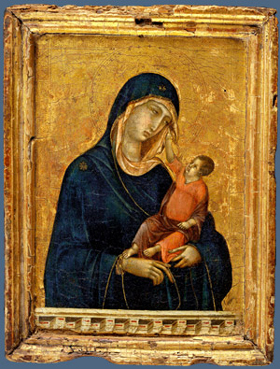1.10.25 — Looking Halfway Ahead
To wrap up from last time on early Renaissance Siena, an altarpiece by Pietro in Pieve has its own Gothic architecture, with the main panel supporting a seeming church tower, and the gold background could almost pass for sky.  Ambrogio takes one inside, his three-tiered household as three acts in a domestic drama. He gives people the run of the streets.
Ambrogio takes one inside, his three-tiered household as three acts in a domestic drama. He gives people the run of the streets.
With Martini’s Orsini Polyptich, the cast moves every which way in the shallow space below the cross. They spill out from the city’s gates. Their gestures and props create a near chaos of competing pagans and worshippers.
The protagonists have a greater freedom and responsibility as well. Mary can draw back or look up from the angel of the Annunciation, her prayer book fallen aside. Martini’s Saint John has unkempt blond hair and clasped hands, at once youthful and reserved. His Pontius Pilate may be winning the argument with Jesus. More often, his bust-length saints glower, much as for Cimabue decades before in Florence. Miracles have becomes matters of fact.
Technique has a greater variety as well. Ambrogio sketches on plaster in sinopia, the earth pigment often used for the preliminary layer that a fresco will efface. Its faint outlines have survived, though, like the first thoughts of an artist today. He also plays with gold leaf as at once background, a tooled halo, and jewelry for Mary herself. So much for the Virgin’s modesty. The red of simulated marble for Pietro could pass for blood.
By 1350, all four artists and their rivals were dead. Still, the black plague was about to set in, taking perhaps a third of the population. Historians have long seen it as bringing a premature end to the Renaissance’s cautious or daring beginning. Art after Giotto in Florence will look dour and disheartened as well. It can only look back. Whether Siena ever could look ahead must remain up for debate.
The curators have a lot to reconstruct and far to travel. It shows in their affiliations alone—Stephan Wolohojian of the Met, Laura Llewellyn of London’s National Gallery, and Caroline Campbell of Ireland’s National Gallery, with Joanna Cannon of the Courtauld Institute in London. They were bound to open with the Met’s Stoclet Madonna, and they were bound to describe it in glowing terms. Mostly, though, they supply a convincing back and forth between context and the four leading artists. They also pause for large works and works in series. One need never get lost in the maze of dark walls.
They do not, though, include contact with Florence or classicism. Nicola Pisano, who worked between Florence and Pisa shortly before, was closer than those here to ancient Rome and its influence. His sculpture looks ahead to Lorenzo Ghiberti, Andrea del Verrocchio, Donatello, and Michelangelo in the next century. The show does stop in Assisi, but with no indication that Giotto may have worked there, and in Arezzo, but with no mention of Piero della Francesca and his frescoes there yet to come. A comparison could have added context, just as in paired slides in a lecture. The Met, though, has a case to make, a case for Siena.
Read more, now in a feature-length article on this site.